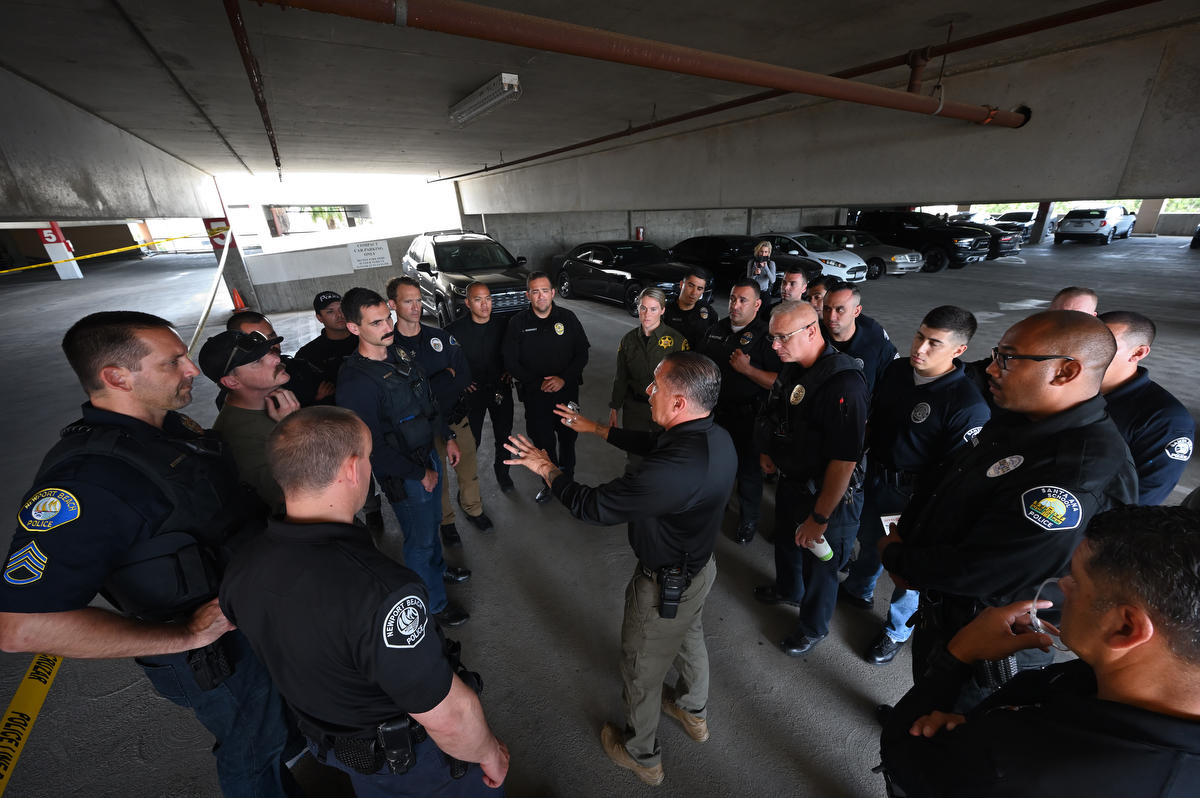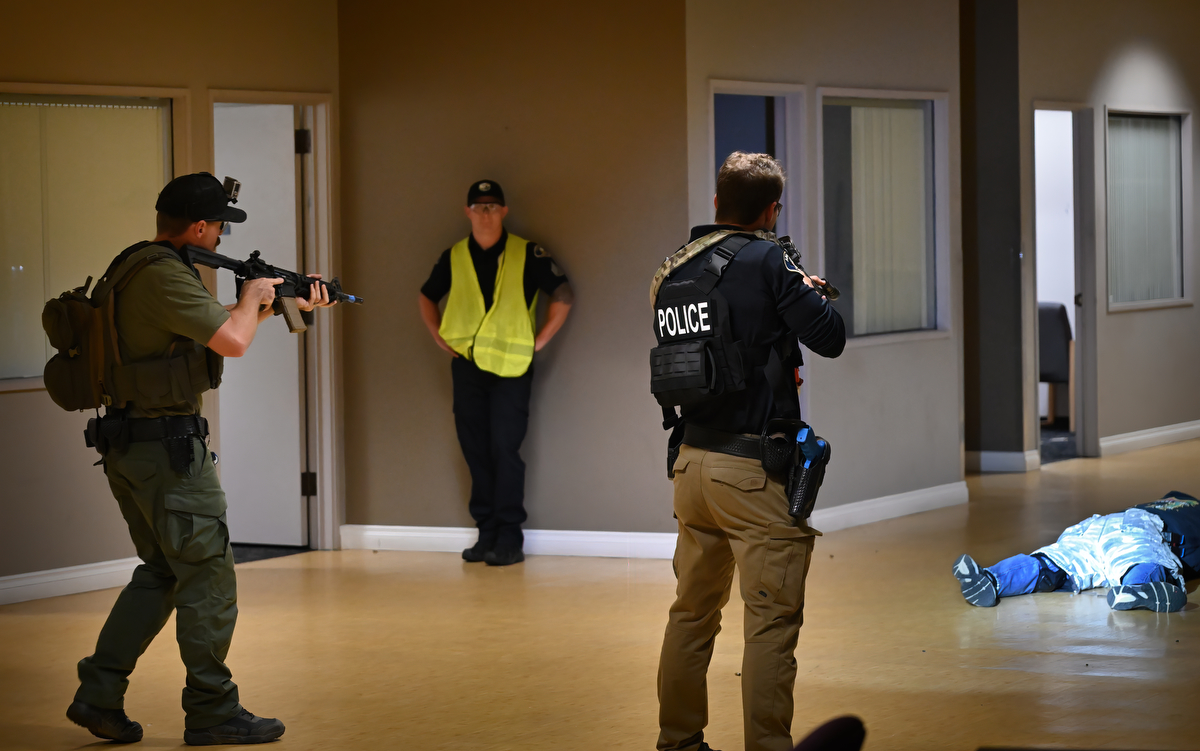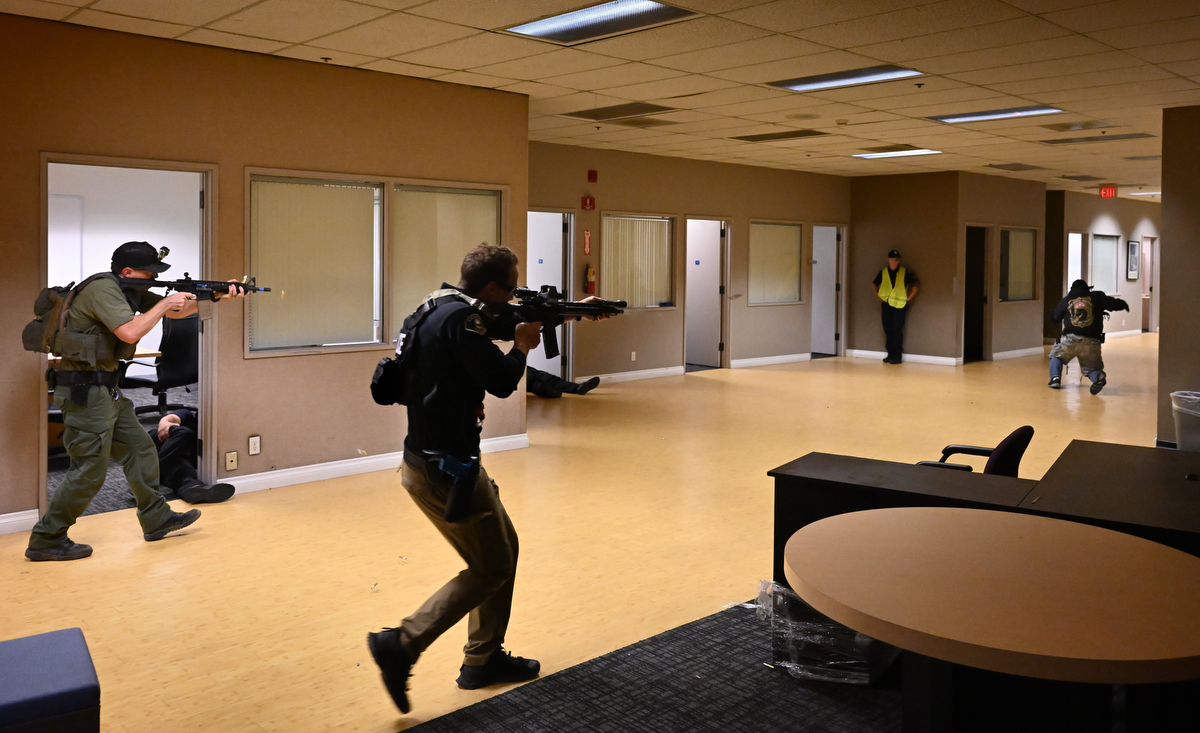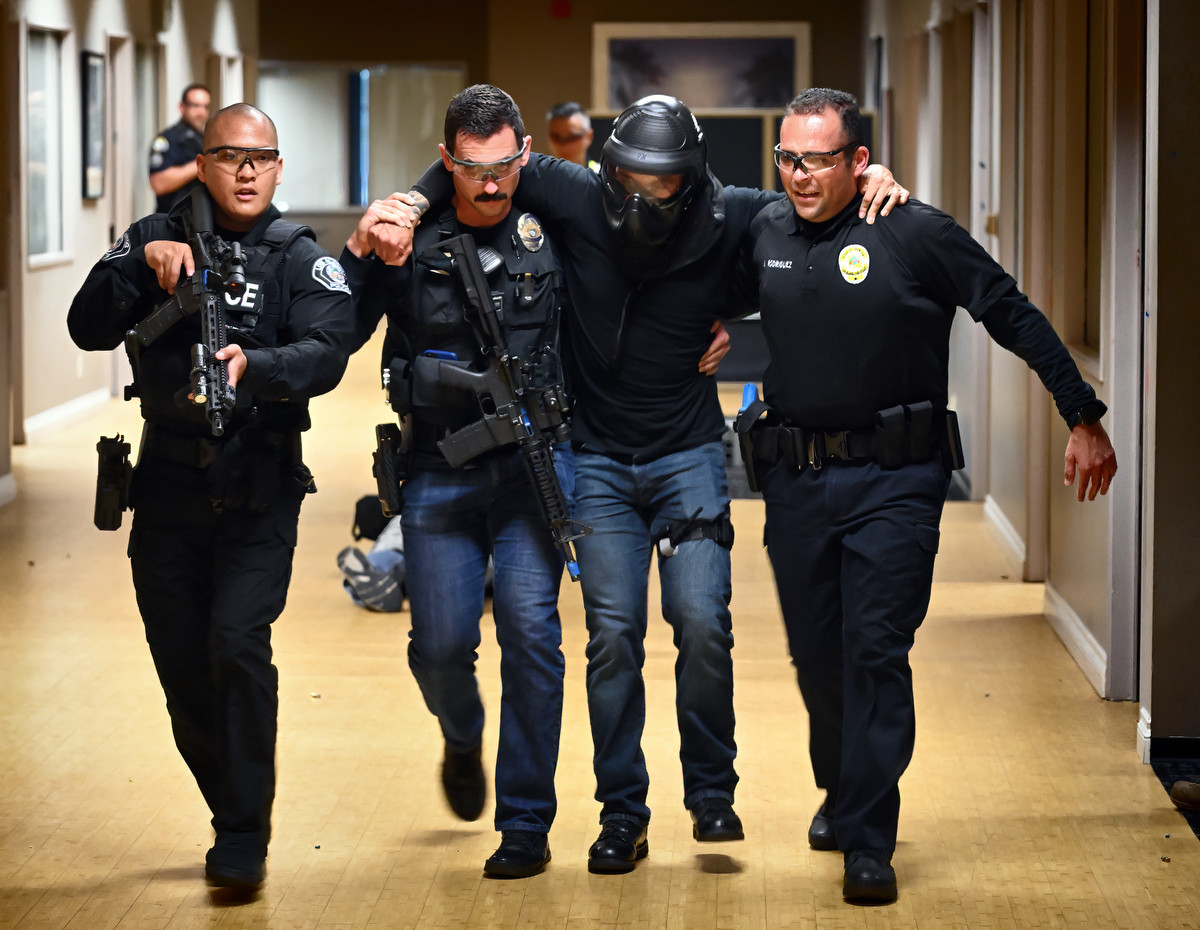A disgruntled former employee has been spotted on the premises of his former place of employment — armed with a hand gun and loading a rifle from the back of his car.
A call comes into police dispatchers, who relay these few details to officers on patrol.
Multiple agencies respond simultaneously, with only seconds to assess a fast moving, potentially deadly situation and take whatever action is needed to neutralize the threat and save lives.

Santa Ana police officers move closer to the building during an active shooter training session at the old OC Register building.
Photo by Steven Georges/Behind the Badge
This scenario, which was played out at the five-story former headquarters of the Orange County Register building in Santa Ana, wasn’t real, and instead was the culmination of a three-day, multi-agency active shooter training course overseen by Santa Ana Police Commander Oscar Lizardi and a team of instructors.

Santa Ana PD Sgt. Oscar Lizardi, center, gives a briefing to officers from various agencies before the start of an active shooter training session at the old OC Register building in Santa Ana.
Photo by Steven Georges/Behind the Badge
“These are mostly law enforcement officers on the front lines who would likely be the first to respond to active shooter situations before SWAT and medical teams arrive,” said Lizardi, who has served as an instructor for active shooter training for years and is the team leader for Santa Ana Police Department’s SWAT team. “We give a very realistic scenario. The scenarios are complex, but as challenging as they are, these officers could very well see one their next day on the job.”
During the training, dispatchers inform the officers en route that the suspect is now inside the building and shots are being fired. Armed with high-capacity assault rifles firing artificial rounds, the main goal of the multi-agency response is to enter quickly and neutralize the threat, “however that might happen,” Lizardi said.

A pretend suspect, right, lies on the floor after shooting at the officers during an active shooter training exercise in the old OC Register building. The officer standing with a yellow vest is one of the instructors monitoring the exercise.
Photo by Steven Georges/Behind the Badge
In these situations, the “suspect usually wants to get their 15 minutes of fame and create as much chaos and death as they can in a short period of time,” the commander said.
Once the shooter has been stopped, responders focus their attention on providing aide to casualties, he said. In this case, the suspect was shot and killed by officers. Had responders determined that the situation involved a suspect taking hostages and barricading himself inside, the response would have been different. And if the situation were less urgent, law enforcement officers would have used different tools and resources, and a different approach.

Police officers make their way down the hall during an active shooter training session at the old OC Register building. Officers acting as injured people screaming for help line the doorways. Officers are trained to ignore them and take out the active shooter before attending to any injured people. The pretend suspect, right, turns to fall after being shot.
Photo by Steven Georges/Behind the Badge
“The key thing is here that we do not have time on our side,” Lizardi said. “Because of that, we explain to them and we train them for the primary purpose of saving lives.”
Training officers on the proper response to active shooter scenarios is personal for Lizardi.
On Oct. 6, 1998, six months prior to the mass shooting at Columbine High School and before the phrase “active shooter” was part of law enforcement vernacular, Lizardi was a young officer responding to a situation similar to the one being played out in the training, involving an angry ex-employee of the City of Riverside who showed up at City Hall with a gun.

An Anaheim PD Officer enters a hallway during an active shooter training session. The officer behind him in the yellow vest is a training officer.
Photo by Steven Georges/Behind the Badge
The shooter, Joseph Neale Jr., had shot and wounded the mayor, four city council members, and three police officers before being shot and wounded himself by police, who then rescued the hostages.
“We had no training with regards to active shooters,” Lizardi recalls. “I heard the shots. We just started going towards what we believed to be the threat. We could hear people pleading for their lives. We made the decision to breach the door. When we did, three of our officers were shot. The suspect was then shot and neutralized.”
The FBI, which noted 61 active shooter situations in 2021, defines an active shooter as “one or more individuals actively engaged in killing or attempting to kill people in a populated area.”
Active shooter training classes are held up to 12 times per year, Lizardi said, and nearly 3,000 first responders in the county have participated in the course.
The training was funded by a county grant and participating agencies included Anaheim, Santa Ana, Tustin, Newport Beach and Los Alamitos police departments. Some participants were veteran officers and others were new, which is exactly how situations could play out in real life, Lizardi said.

Police escort a pretend injured person at the conclusion of an active shooter training exercise inside the old OC Register building.
Photo by Steven Georges/Behind the Badge
Newport Beach Police Officer Steven Arnett was participating in the training for the first time.
“I signed up a while ago to better myself as an officer and better my responses to certain things.” Arnett said. “Continuing to train and stay on top of my skills, to be able to better them, is really what I wanted to get out of this course.”
“Any time we interact with other agencies it’s good to be cohesive and be somewhat on the same page,” he added, “and be able to coordinate to make things as streamlined as they can be, especially in a hectic situation.
Policies can differ among multiple agencies, so training together is critical, said Sgt. Ryan Hunter of Anaheim Police Department, an instructor for the class.
“These events impact everyone,” Hunter said. “The more that we can come together and coalesce our efforts and know how each agency moves and respond, the better off our response is going to be for us as an agency and for the community at large.”
 Behind the Badge
Behind the Badge




